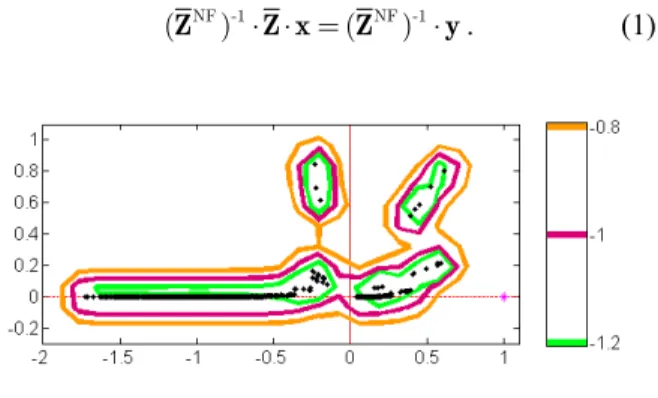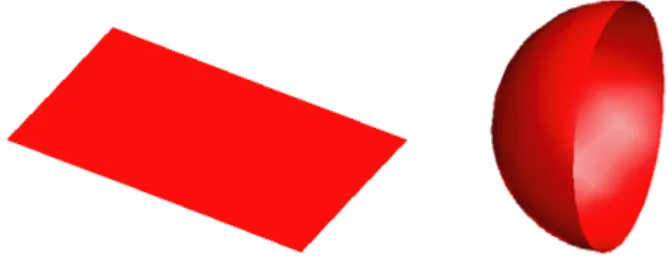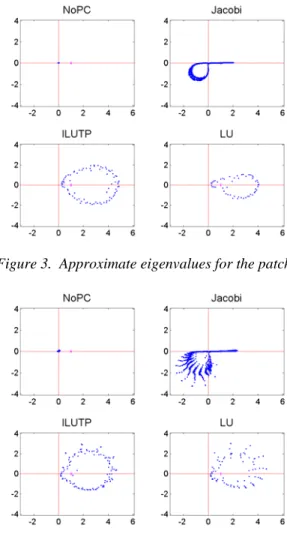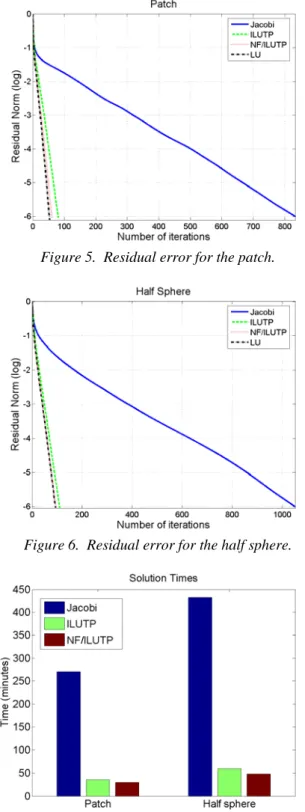INCOMPLETE LU PRECONDITIONING
FOR THE ELECTRIC-FIELD INTEGRAL EQUATION
Tahir Malas 1
and Levent Gürel 1, 2 1
Department of Electrical and Electronics Engineering, Bilkent University, TR-06800, Bilkent, Ankara, Turkey
2
Computational Electromagnetics Research Center (BiLCEM), Bilkent University, TR-06800, Bilkent, Ankara, Turkey Email: tmalas@ee.bilkent.edu.tr,lgurel@bilkent.edu.tr
ABSTRACT
Linear systems resulting from the electric-field integral equation (EFIE) become ill-conditioned, particularly for large-scale problems. Hence, effective preconditioners should be used to obtain the iterative solution with the multilevel fast multipole algorithm in a reasonable time. In this paper, we show that a threshold-based incomplete LU (ILU) preconditioner, i.e., ILUT, can be used safely for such systems, provided that column pivoting is applied for the stability of the incomplete factors. It is observed that the resulting preconditioner ILUTP reduces the solution times by an order of magnitude, compared to simple Jacobi preconditioner. Moreover, we also use the iterative solution of the near-field system as a preconditioner, and use ILUTP as the preconditioner for the near-field system. This way, the effectiveness of the ILUTP is further improved
1. INTRODUCTION
In this work, we consider the solution of large electromagnetic scattering problems involving three-dimensional targets. For the geometries having open surfaces, only the electric-field integral equation (EFIE) can be used to formulate the induced current on the target surface. Then, the integral equation is discretized by the method of moments, yielding dense complex systems in the form of Z x⋅ =y. Using the multilevel fast multipole algorithm (MLFMA) [1], the solutions to the dense systems can be obtained with low computational complexity.
However, EFIE produces linear systems which are difficult to solve iteratively. In Fig. 1, we show the pseudospectra of an EFIE matrix, related to a small problem with 930 unknowns. The matrix properties are very unfavorable for the iterative solution. The eigenvalues are scattered, especially along the left half-plane, making the matrix highly indefinite. Moreover, some pseudospectra include the origin, signalling the near-singularity of the matrix. Hence effective preconditioning strategies are indispensable for robustness and effectiveness.
To reduce the storage requirement, MLFMA stores only the near-field part of the coefficient matrix, denoted by
NF
Z . Since this is the best available approximation to the system matrix Z, we can use it as a preconditioner and solve (for example) the left-preconditioned system
NF -1 NF -1
(Z ) ⋅ ⋅Z x= (Z ) ⋅y. (1)
Figure 1. Pseudospectra of an EFIE matrix at the levels of 10-0.8,10-1, and 10-1.2. The black dots are the eigenvalues.
The solution of the system with the near-field matrix can be performed via LU factorization. However, during the factorization of unstructured sparse matrices, fill-in occurs and sparsity is lost. Nonetheless, by sacrificing some (hopefully) unimportant elements during the factorization, we end up with an incomplete LU (ILU) preconditioner. These preconditioners work well in many areas of scientific computation [2].
In this paper, we show that among various ILU preconditioners, ILUT [3] is effective for EFIE systems. However, for some geometries, no progress may be observed towards convergence. We show that this occurs because of the instable incomplete factors. To overcome the problem, we apply column pivoting as suggested in [4]. The resulting preconditioner is called ILUTP. With this remedy, we achieve convergence with iteration counts that are close to those obtained by using the exact factorization of the near-field matrix. To further increase the effectiveness of the preconditioner, we can use a flexible solver, which allows the preconditioner to vary from one iteration to another. Then, we precondition the original system using another iterative solver. We propose to solve the near-field system with the inner solver, and use ILUT as the preconditioner. Our experiments reveal that, by
using only a few iterations for the inner system, the number of outer iterations further drops compared to using ILUT alone.
ILU preconditioners are used in the context of MLFMA before in [7] – [9]. ILU(0) is shown to be successful in [7], but it produced discouraging results in another work [8]. Later, ILUT was used with the hybrid surface-volume integral equations and shown to be successful on many test problems [9]. However, the study neither includes the commonly used EFIE formulation, nor the application of pivoting or any other techniques to increase the robustness of the preconditioner.
This paper is organized as follows. In the next section, we explore ILU preconditioning in more detail. Then, numerical experiments are demonstrated in Section 3. Concluding remarks about the numerical results are given in Section 4.
2. INCOMPLETE LU PRECONDITIONING Two kinds of ILU preconditioners are proposed depending on the criteria for the elimination of the matrix entries. The first set of preconditioners, namely, the level-of-fill methods, drop matrix entries based on their locations. For example, consider an incomplete factorization of the near-field matrix, ZNF ≈ ⋅UL . If we retain the nonzero values of L and U only at the nonzero positions of ZNF, we obtain the most common level-of-fill ILU preconditioner, called ILU(0). For positive definite or diagonally dominant systems, this simple idea works well.
On the other hand, for matrices that are far from being diagonally dominant and indefinite, ILU(0) becomes ineffective in predicting the locations of the largest entries, since it does not consider the numerical values. Hence, other ILU preconditioners are developed, which are based on the principle of dropping the matrix elements depending on their magnitudes. Among such methods, ILUT is successful for systems obtained from a wide range of applications [5]. ILUT uses two parameters: a threshold τ and the maximum number of nonzero elements per row p. During the factorization, matrix elements that are smaller than the prescribed threshold τ times the 2-norm of the current row are dropped. Then, of all the remaining entries, no more than the p largest ones are kept. For ill-conditioned matrices, ILUT is known to yield more accurate factorizations compared to level-of-fill methods with the same amount of fill-in [4]. Moreover, the computational requirements can be controlled with the help of the parameters.
Despite these advantages, ILUT sometimes suffers from instability. Even if the factorization terminates normally, the incomplete factors may turn out to be
unstable, rendering them useless for preconditioning. The common reasons for instability are, in general, excessive dropping and small pivots [4]. If the problem is related to the small pivots, one can significantly increase the robustness of the preconditioner by using partial pivoting as in the complete factorization case. The resulting preconditioner is called ILUTP.
In order to understand the stability of the preconditioner, we can use the norm
1
( )− , [1,1, 1]T
∞
⋅ ⋅
L U e e = K , (2)
which is called condest (for condition estimate). The condest value gives an idea about the stability of the incomplete factors because it provides an upper bound for (L U⋅ )−1 [4]. If the condest value is not very high, but the preconditioner still does not work, we can deduce that fill-in should be increased. On the other hand, if the condest value is high, one should first try pivoting for a less expensive remedy.
3. RESULTS
To test the effectiveness of the ILU preconditioners on EFIE systems, we solve several scattering problems. Among them, we present results for two representative geometries, a patch (P) and a half sphere (HS), which are shown in Fig. 2.
Figure 2. Patch and half sphere geometries.
We fix the threshold parameter τ at 10-6 and p to be the same as the average nonzero elements per row of the near-field matrix. This way, the storage cost of ILUT becomes similar to that of ILU(0).
As the iterative solver, we use GMRES with no restart for robustness purposes. Starting with the zero initial guess, we stop the iterations when the initial residual norm is reduced by six orders of magnitude.
In Table 1, we show the condest values and iteration counts for ILU(0), ILUT, ILUTP, and LU. ‘N’ denotes the number of unknowns. We use 0.5 permutation tolerance for ILUTP, which means pivoting is applied if the pivot candidate is at least two times larger than the diagonal element. LU denotes the exact factorization of the near-field matrix. This preconditioner does not have
a practical use due to its high cost. It is shown merely as a benchmark to test how well the ILU preconditioners approximate the near-field matrix.
Geom- ILU(0) ILUT ILUTP LU
etry
N
cond iter cond iter cond iter iter
P 137,792 6.E+09 - 1398 82 1350 81 53 HS 116,596 6.E+05 - 2.E+15 - 582 110 93 Table 1. condest and iteration counts. “-” denotes that
convergence is not attained in 1500 iterations.
The condest values in Table 1 indicate that ILU(0) produces highly unstable factors for large problem sizes. For smaller sizes, ILU(0) may be successful as in [7] because of two reasons. First, the near-field matrix is
not very sparse for small problems. For example, a 930
unknown problem contains, on the average, 224 nonzero elements per row if the size of the smallest cluster is fixed as 0.25λ, which is a common choice. Secondly, it is known that, as the problem size becomes larger, EFIE produces increasingly ill-conditioned matrices [6], for which ILU(0) is less likely to become successful.
ILUT works well for the patch problem, but for the half sphere, it produces instable factors as can be noticed from the very high condest value. With pivoting, the difficulty is removed, and convergence is attained with low iteration counts.
For a deeper understanding of the effect of the preconditioners on the EFIE systems, we also show in Figs. 3 and 4 the distribution of the approximate eigenvalues for the no-preconditioning, Jacobi, ILUTP, and LU cases. These eigenvalues are obtained as a by-product of the GMRES solver. The approximation to the outer eigenvalues are better. As seen in the figures, ILUTP preconditioner clusters the eigenvalues on the right half-plane with a reasonably small radius. Hence, GMRES iteration converges a lot faster [10].
Even though the iteration numbers of ILUTP are not far from those of the LU preconditioner, we can provide a better approximation to the near-field matrix by using the iterative solution of the near-field system as a preconditioner. For this purpose we use a flexible solver to solve the EFIE system, which allows the preconditioner to vary at each iteration. Hence, this approach results in a two-level iterative solver. The outer solver is used for the solution of the original system, and the inner solver is used for preconditioning the original system. We propose to solve the near-field system with the inner solver, and use ILUTP as the preconditioner. We use GMRES again as the inner solver since it is effective for reducing the residual norm in the early iterations. Our experiments reveal that only
three iterations suffice to obtain a good approximation to the exact solution of the near-field matrix. We name this preconditioner NF/ILUTP.
Figure 3. Approximate eigenvalues for the patch.
Figure 4. Approximate eigenvalues for the half sphere.
In Figs. 5 and 6, we show iterations versus residual norm for the patch and the half sphere, respectively. We compare the aforementioned preconditioners with the simple Jacobi preconditioner to show that, in the absence of a strong preconditioner, it is difficult to solve these systems even with a robust solver. We also note that both ILUTP and NF/ILUTP iteration counts turn out to be close to the LU preconditioner.
Since the main goal in preconditioning is to reduce the total solution time, we compare the total solution times (setup + iterative phase) of the preconditioners in Fig. 7. ILUTP reduces the total solution time by nearly an order of magnitude with respect to the Jacobi preconditioner. NF/ILUTP further drops the total time compared to ILUTP.
Figure 5. Residual error for the patch.
Figure 6. Residual error for the half sphere.
Figure 7. Total solution times for the two geometries.
4. CONCLUSION
In this work, we show that a thresholding-based ILU preconditioner, namely, ILUTP, can be safely applied to electromagnetic scattering problems. We use no more storage with respect to the near-field matrix, and the resulting preconditioner accelerates the iterative solver dramatically.
As a further improvement, we apply ILUTP to the iterative solution of the near-field system, and then use this solution as a preconditioner to the original EFIE system. This approach increases the effectiveness of the preconditioner. It is also applicable to parallel implementations, because it requires only sparse matrix-vector products, which can be efficiently parallelized. ACKNOWLEDGEMENTS
This work was supported by the Scientific and Technical Research Council of Turkey (TUBITAK) under Research Grant 105E172, by the Turkish Academy of Sciences in the framework of the Young Scientist Award Program (LG/TUBA-GEBIP/2002-1-12), and by contracts from ASELSAN and SSM. REFERENCES
1. Lu C.-C. and Chew W. C., “Multilevel fast multipole algorithm for electromagnetic scattering by large complex objects,” IEEE Trans. Antennas Propagat., Vol. 45, 1488–1493, 1997.
2. Chen K., Matrix Preconditioning Techniques and
Applications, Cambridge University Press, 2005.
3. Saad Y., “ILUT: a dual threshold incomplete LU factorization,” Numer. Linear Algebra Appl., Vol. 1, 387–402, 1994.
4. Chow E. and Saad Y., “Experimental study of ILU preconditioners for indefinite matrices,” J. Comput.
Appl. Math., Vol. 86, 387–414, 1997.
5. Benzi M., “Preconditioning techniques for large linear systems: a survey,” J. Comput. Phys., Vol. 182, 418–477, 2002.
6. Gürel L. and Ergül Ö., “Comparisons of FMM implementations employing different formulations and iterative solvers,” in Proc. IEEE AP-S Int. Symp., Columbus, OH, Vol. 1,. 19–22, Jun. 2003.
7. Sertel K. and Volakis J. L., “ILU preconditioner for fast multipole method (FMM),” Microwave Opt.
Technol. Lett., Vol. 28, 265–267, 2000.
8. Carpentieri B., Duff I. S., and Giraud L., “Experiments with sparse preconditioning of dense problems from electromagnetic applications,” Technical
Report, TR/PA/00/04, CERFACS, 1999.
9. Lee J., Zhang J., and Lu C., “Incomplete LU preconditioning for large scale dense complex linear systems from electromagnetic wave scattering problems,” J. Comput. Phys., Vol. 185, 158–175, 2003. 10. Trefethen L. N., and Bau, III D., Numerical Linear



